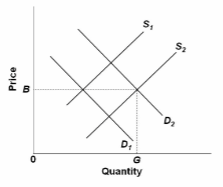Suppose the market-clearing price of wheat is $2.50 per bushel. What would happen if wheat farmers persuaded the government to set a legally-mandated price support of $3.75 per bushel?
A) The quantity demanded of wheat would fall.
B) The quantity supplied of wheat would rise.
C) A surplus of wheat would occur.
D) All of the above.
D
You might also like to view...
An example of a U.S. import would be:
A. a French bottle of wine consumed by an American. B. an Apple computer, made in the U.S., purchased by a U.S. college student who plans to study abroad in France. C. a bushel of apples that Canadians pick and enjoy during a lovely fall day in Vermont. D. an Apple computer, made in the U.S., purchased by a French student.
The central banks of many developing countries choose to pursue policies that generate high levels of inflation, because the benefits of doing so seem to exceed the costs.
Answer the following statement true (T) or false (F)
The market in which the currency of one country is traded for the currency of another country is called
A. the futures market. B. the commodities market. C. the foreign exchange market. D. the international trade market.
Refer to the competitive market diagram for product Z. Assume that the current market demand and supply curves for Z are D 2 and S 2 . If there are substantial external costs associated with the production of Z, then:

A. a price lower than B and an output greater than G would improve resource allocation.
B. government should levy a per-unit excise tax on Z to shift the demand curve to the right.
C. government should levy a per-unit excise tax on Z to shift the supply curve toward S 1 .
D. government should subsidize the production of Z to lower equilibrium price and increase
equilibrium output.